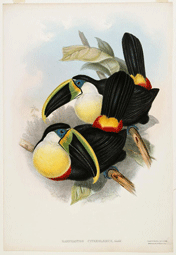Books by John Gould (1804-1881)
incl. Birds of Australia (1837-69), Birds of Europe (1832-1837), Birds of Great Britain (1862-73) and Monograph of the Trochilidae (1849-1887)
WorkThis plate comes from the ‘T. C. Eyton Collection’, which Ruskin bought for the St George’s Museum.The Eyton Collection contains almost 7000 hand coloured prints and watercolour illustrations of birds by John and Elizabeth Gould, but also John James Audubon and Edward Lear. Illustrations of this kind were part of a lengthy production process. First, Gould researched and made preparatory drawings of the birds. Next, he made a watercolour drawing of each bird, either from life or from a stuffed bird. The watercolour would then be reproduced using lithography, a method in which the illustration is accurately re-drawn on stone and printed using greasy ink. The final step was the hand-colouring of each print, using watercolour paint.
ArtistJohn Gould was born in London; he had little education, and no formal art training, yet became famous for research and publication in ornithology. By the age of 21 he had become a taxidermist, working in London. At 24, he became curator of the museum of the Society of Zoology. While researching his books, Gould travelled to Australia and America. By his death in 1881, Gould had published large-scale illustrated books about the birds of every continent except Antarctica. Ruskin on BirdsRuskin bought the Eyton Collection because he valued its 'truthful' representation of birds and their habitats.None of the illustrators in the Eyton collection had received formal art educations.The watercolours and prints all demonstrate a high level of artistic skill, and, more importantly for Ruskin, a habit of exact observation and 'truth to nature'. He wished to inspire the same reverence for detail in visitors to the St George’s Museum. Museum LibraryThe Museum had an extensive library. Its non-manuscript collections divide into these subject areas:B. WORKS OF TRAVELI. Early Voyages of Discovery II. Ancient AtlasesC. NATURAL HISTORYI. Mineralogy II. Botany III. ZoologyD. THE FINE ARTSI. Collection of the Guild of St George, Museums Sheffield
Arts of Ancient Greece and Rome
(a) Sculpture (b) Coins and GemsII. The Plastic Arts III. Metal WorkIV. Early Drawings, and Engravings (a) The Early Italian and German Master (b) Recent English Engravings (c) Recent English Drawings (d) Black and White DrawingsE. CLASSICAL LITERATUREI. Greek-English Translations of Homer II. French III. EnglishF. BRITISH HISTORYG. GENERAL LITERATUREI. Works Appertaining to the History of Art II. Biographical Works III. Miscellaneous Works Museum Book ShelvesThe Museum's book shelves were vividly described in an article published in the Magazine of Art in 1879:'On the shelves we recognise Bacon, and salute Chaucer. We bow to Dr. Johnson, and recognise Pope. Here, is "John Guillim's Heritorie," and Richard Hakluyt's "Voyages;" A. J. and E. Le Blunt's "Histoire de la Porcelaine," and Joseph Marryatt's "History of Pottery," together with several volumes of "Natural History." Our attention is now drawn to a splendid edition of books bound in brave green morocco. They are a complete set of the works of Mr. Ruskin's comrade, Thomas Carlyle [...] There are drawerfuls of Mr. Ruskin's own writings. There is a covetable collection of his standard books, an édition de luxe, bound in blue. The edition is a model of typographical excellence; it is a positive luxury to peruse such type, and revel in such paper. [...] Here are pamphlets without end.' (III, December, 1879, pp. 57-60 (p. 60)) |



















